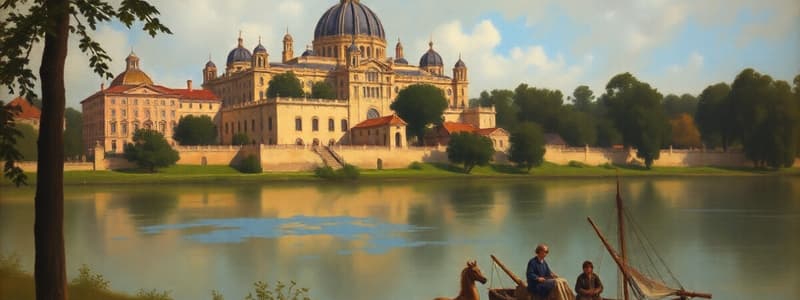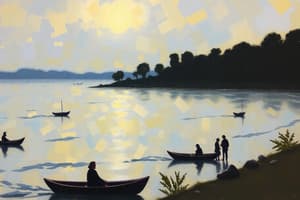Podcast
Questions and Answers
When analyzing a primary source, what is the significance of considering its physical nature, such as the type of paper used or the handwriting style?
When analyzing a primary source, what is the significance of considering its physical nature, such as the type of paper used or the handwriting style?
- The physical attributes can offer insights into the author's social status, resources, and the intended audience. (correct)
- It primarily helps in determining the monetary value of the document.
- The physical nature has no bearing on the historical context of the source.
- It is only relevant for verifying the authenticity of the document.
In the context of the 6 C's for analyzing primary sources, what does 'Communication' primarily involve?
In the context of the 6 C's for analyzing primary sources, what does 'Communication' primarily involve?
- Determining the contributions of the primary source to our understanding of history.
- Understanding the biases, prejudices, and point of view of the author. (correct)
- Identifying the main idea and important points within the source material.
- Recognizing the connection of the primary source to existing historical knowledge.
How did Juan de Plasencia contribute to the interaction between the Spanish and the natives in the Philippines?
How did Juan de Plasencia contribute to the interaction between the Spanish and the natives in the Philippines?
- He facilitated communication by promoting the understanding of both Spanish and local languages, and initiated policies for resettling natives. (correct)
- He primarily focused on military strategies to subdue local resistance.
- He concentrated on extracting resources and wealth for the Spanish crown, disregarding native welfare.
- He advocated for the complete segregation of Spanish colonizers and native populations.
How were slaves able to elevate their social status in ancient Philippines?
How were slaves able to elevate their social status in ancient Philippines?
What role did the chieftain play in the administration of justice within a barangay?
What role did the chieftain play in the administration of justice within a barangay?
What does the term 'Aliping Namamahay' refer to in the social structure of ancient Philippines?
What does the term 'Aliping Namamahay' refer to in the social structure of ancient Philippines?
How does understanding the 'Context' of a primary source contribute to its analysis based on the 6 C's?
How does understanding the 'Context' of a primary source contribute to its analysis based on the 6 C's?
What was the primary purpose of the 'Putong' worn by males in ancient Philippines?
What was the primary purpose of the 'Putong' worn by males in ancient Philippines?
Which of the following aspects is most important to consider when determining the 'Content' of a primary source?
Which of the following aspects is most important to consider when determining the 'Content' of a primary source?
In ancient Philippine marriage customs, what was the significance of 'Bigay-suso'?
In ancient Philippine marriage customs, what was the significance of 'Bigay-suso'?
What distinguishes a primary source from other types of historical documents?
What distinguishes a primary source from other types of historical documents?
During the analysis of a primary source, why is it essential to consider the author's background, including factors like race, sex, class, and political beliefs?
During the analysis of a primary source, why is it essential to consider the author's background, including factors like race, sex, class, and political beliefs?
What policy was initiated by Juan de Plasencia to more effectively administer and Christianize the native population?
What policy was initiated by Juan de Plasencia to more effectively administer and Christianize the native population?
According to the social hierarchy in ancient Philippines, what distinguished the 'Maharlika' from other groups?
According to the social hierarchy in ancient Philippines, what distinguished the 'Maharlika' from other groups?
What role does 'imagination' play in the analysis of primary sources?
What role does 'imagination' play in the analysis of primary sources?
What is the significance of 'Citation' in the context of analyzing primary sources according to the 6 C's?
What is the significance of 'Citation' in the context of analyzing primary sources according to the 6 C's?
In the context of ancient Philippine society, what was the general marital arrangement?
In the context of ancient Philippine society, what was the general marital arrangement?
Which of the following best describes the writing system used by ancient Filipinos?
Which of the following best describes the writing system used by ancient Filipinos?
In analyzing primary sources, what is the significance of understanding the 'Conclusions' that can be drawn from the source?
In analyzing primary sources, what is the significance of understanding the 'Conclusions' that can be drawn from the source?
What was the initial step in courtship in ancient Philippines?
What was the initial step in courtship in ancient Philippines?
When examining primary sources, what does it mean to consider the 'Connections' of the source, according to the 6 C's?
When examining primary sources, what does it mean to consider the 'Connections' of the source, according to the 6 C's?
Understanding the 'purpose' of a primary source involves:
Understanding the 'purpose' of a primary source involves:
Which of the following is NOT a recommended question to ask when analyzing a primary source?
Which of the following is NOT a recommended question to ask when analyzing a primary source?
According to the information provided, who can be a historian?
According to the information provided, who can be a historian?
The analysis of primary sources is best achieved through:
The analysis of primary sources is best achieved through:
What did ancient Filipinos use as ink?
What did ancient Filipinos use as ink?
What is the significance of understanding the biases in a primary source?
What is the significance of understanding the biases in a primary source?
Which of the following is an example of a primary source?
Which of the following is an example of a primary source?
How did Juan de Plasencia contribute to primary education?
How did Juan de Plasencia contribute to primary education?
What is a 'bias' in the context of analyzing primary sources?
What is a 'bias' in the context of analyzing primary sources?
In ancient Philippines, what was the role of 'Balangaw' in their religious beliefs?
In ancient Philippines, what was the role of 'Balangaw' in their religious beliefs?
In the absence of male heirs, who would succeed the barangay chieftain?
In the absence of male heirs, who would succeed the barangay chieftain?
Which of the following is NOT a way a person could become a slave in ancient Philippines?
Which of the following is NOT a way a person could become a slave in ancient Philippines?
What type of material was used to write and create records?
What type of material was used to write and create records?
Is there only one interpretation when analyzing a primary source?
Is there only one interpretation when analyzing a primary source?
The barangay is composed of how many families?
The barangay is composed of how many families?
What kind of tool did they use as a pencil?
What kind of tool did they use as a pencil?
What are the ways on how slaves can be emancipated?
What are the ways on how slaves can be emancipated?
How does considering the physical characteristics of a primary source, such as the writing material or handwriting, enhance historical analysis?
How does considering the physical characteristics of a primary source, such as the writing material or handwriting, enhance historical analysis?
In analyzing primary sources using the 6 C's, how does understanding the 'Context' of a document most significantly aid in its interpretation?
In analyzing primary sources using the 6 C's, how does understanding the 'Context' of a document most significantly aid in its interpretation?
Considering Juan de Plasencia's role in the Philippines, how did his efforts to promote the Spanish language and local languages contribute to Spanish colonization?
Considering Juan de Plasencia's role in the Philippines, how did his efforts to promote the Spanish language and local languages contribute to Spanish colonization?
How did the structure of the ancient barangay system, with its defined social classes, influence social mobility?
How did the structure of the ancient barangay system, with its defined social classes, influence social mobility?
What does the practice of 'Paninilbihan' in ancient Philippine courtship rituals reveal about societal values during that era?
What does the practice of 'Paninilbihan' in ancient Philippine courtship rituals reveal about societal values during that era?
Flashcards
Primary Source
Primary Source
Documents or artifacts created by a witness to or participant in an event, offering firsthand testimony or evidence from the studied time period.
Analyzing Primary Sources
Analyzing Primary Sources
Questioning sources, using historical imagination, and considering different interpretations.
Historical Analysis
Historical Analysis
Examining journals, newspapers, letters, court records, novels, artworks, music or autobiographies from a specific period.
Analyzing a Primary Source
Analyzing a Primary Source
Signup and view all the flashcards
Content (Primary Source Analysis)
Content (Primary Source Analysis)
Signup and view all the flashcards
Citation (Primary Source Analysis)
Citation (Primary Source Analysis)
Signup and view all the flashcards
Communication (Primary Source Analysis)
Communication (Primary Source Analysis)
Signup and view all the flashcards
Context (Primary Source Analysis)
Context (Primary Source Analysis)
Signup and view all the flashcards
Connections (Primary Source Analysis)
Connections (Primary Source Analysis)
Signup and view all the flashcards
Conclusions (Primary Source Analysis)
Conclusions (Primary Source Analysis)
Signup and view all the flashcards
Juan de Plascencia
Juan de Plascencia
Signup and view all the flashcards
Reduction Policy
Reduction Policy
Signup and view all the flashcards
Barangay
Barangay
Signup and view all the flashcards
Maharlica (Nobles)
Maharlica (Nobles)
Signup and view all the flashcards
Aliping Namamahay (Commoners)
Aliping Namamahay (Commoners)
Signup and view all the flashcards
Aliping Saguiguilid (Slaves)
Aliping Saguiguilid (Slaves)
Signup and view all the flashcards
Putong
Putong
Signup and view all the flashcards
Barangay Government
Barangay Government
Signup and view all the flashcards
Chieftain's Function
Chieftain's Function
Signup and view all the flashcards
Dispute Settlement
Dispute Settlement
Signup and view all the flashcards
Inheritance (Chieftain)
Inheritance (Chieftain)
Signup and view all the flashcards
Becoming a Slave
Becoming a Slave
Signup and view all the flashcards
Emancipation of Slaves
Emancipation of Slaves
Signup and view all the flashcards
Panghihimuyat
Panghihimuyat
Signup and view all the flashcards
Bigay-kaya
Bigay-kaya
Signup and view all the flashcards
Marriage Customs
Marriage Customs
Signup and view all the flashcards
Dowry
Dowry
Signup and view all the flashcards
Bathala
Bathala
Signup and view all the flashcards
Idayanale
Idayanale
Signup and view all the flashcards
Sidarapa
Sidarapa
Signup and view all the flashcards
Agni
Agni
Signup and view all the flashcards
Balangaw
Balangaw
Signup and view all the flashcards
Mandarangan
Mandarangan
Signup and view all the flashcards
Lalahon
Lalahon
Signup and view all the flashcards
Siginarungan
Siginarungan
Signup and view all the flashcards
Superstitious Beliefs
Superstitious Beliefs
Signup and view all the flashcards
Magical Power
Magical Power
Signup and view all the flashcards
Major Languages
Major Languages
Signup and view all the flashcards
System of Writing
System of Writing
Signup and view all the flashcards
Writing Materials
Writing Materials
Signup and view all the flashcards
Writing Tools
Writing Tools
Signup and view all the flashcards
Study Notes
Analyzing Primary Sources
- A primary source includes documents or artifacts created by witnesses or participants in an event.
- Primary sources provide direct evidence of human activity and are actual records that have survived from the past.
- Analyzing a primary source involves examining journals, newspapers, letters, court case records, novels, artworks, music, or autobiographies from the period.
- Interpretation of primary documents differs based on individual experiences and skills.
- Analysis requires information about the document itself and the era from which it originates.
Analyzing Primary Sources - Questions to Ask
- Examine the physical nature of the source to understand its form and context.
- Determine the author's purpose, message, or argument, whether explicit or implicit.
- Identify the methods the author uses to convey the message.
- Research the author's background (race, sex, class, occupation, religion, age, region, political beliefs) and consider its relevance.
- Identify the intended audience and how it affects the source.
- Scrutinize the text or object for language, metaphors, symbols, and word choices.
The 6 C’s of Analyzing Primary Sources
- Content: Identify the main idea and list important points, phrases, words, and sentences for documents, or describe what you see in images.
- Citation: Identify the creator of the document and the time it was created.
- Communication: Identify the author's biases and examine their point of view. A bias is a prejudice or a tendency to see something in a particular way
- Context: Understand the world, country, region, or locality when the document was created.
- Connections: Recognize the connection of the primary source to what you already know.
- Conclusions: Determine the contributions of the primary source to our understanding of history and examine primary sources with a critical eye since they represent unfiltered records of the past.
Juan de Plasencia - Background
- Real name: Joan de Puerto Carrera, Del Convento De Villanueva De La Serena.
- Spanish Friar of the Franciscan order.
- Born in the early 16th century in Plasencia, Extremadura, Spain.
- He was born to the Puerto Carrero family
- Credited with fostering the spread of primary education.
- He converted natives, taught catechisms, and organized towns and barangays in the Philippines.
- Promoted understanding of Spanish among natives and local languages among missionaries.
- Initiated the Reduction Policy to resettle natives in central locations.
- Aimed to end injustices against natives by government officials.
Juan de Plasencia - Arrival in the Philippines
- Credited with founding towns in Bulacan, Laguna and Rizal provinces, such as Tayabas, Caliraya, Lucban, Mahjayjay, Nagcarlan, Lillio(Liliw), Pila, Santa Cruz, Lumban, Pangil, Siniloan, Morong, Antipolo, Taytay, and Meycauayan.
- Elected custos of the friars on May 23, 1584, and held the position until 1588.
- He passed away in Laguna in 1590.
Society
- Tribal gatherings were called Barangays. These consisted of family of parents and children relations and slaves.
- Barangays sometimes consisted of a hundred houses, sometimes even less than thirty.
The Three Castes
- Nobles (Maharlica): The "free-born" who do not pay taxes.
- Commoners (Aliping Namamahay): Live in their own houses, lords of their property and gold.
- Slaves (Aliping Saguiguilid): Serve their master in his house and cultivated land and can be sold.
Mode of Dressing
- Male: Headgear called Putong (symbolizes the number of persons the wearer had killed), jacket with short sleeves called kanggan, and lower garment called bahag.
- Female: Upper garments Baro and Camisa, and lower garment Saya
Ornaments
- Decorative objects add quality or distinction to a person, place, or thing.
Government
- The unit of government is the Barangay ruled by a chieftain, consisting of 30 to 100 families with relatives and slaves.
- The chieftain implements laws, ensures order, and gives protection.
- Disputes were settled by a court of the chieftain and council of elders.
Inheritance
- The 1st son of the barangay chieftain inherits his father’s position
- If the 1st son dies, the 2nd son succeeds
- In the absence of male heirs, the eldest daughter becomes the chieftain
Slaves
- A person becomes a slave by captivity in war, debt, inheritance, purchase, or committing a crime.
- Slaves can be emancipated through forgiveness, paying debt, condonation, bravery, or marriage.
Marriage Customs
- Men were generally monogamous, and their wives were called Asawa.
- Courtship begins with Paninilbihan.
- The man requires to give a dowry: Bigay-kaya (a piece of land or gold), panghihimuyat (a gift for the bride’s parents), Bigay-suso (for bride’s wet nurse).
- Marriage between couples belonging to different social classes were not common.
Religious Belief
- They worship many Gods and Goddesses, including: Bathala (supreme being), Idayanale (God of agriculture), Sidarapa (God of death), Agni (God of fire), Balangaw (God of rainbow), Mandarangan (God of war), Lalahon (God of harvest), and Siginarungan (God of hell).
- Belief in sacred animals and trees also existed.
Superstitious Beliefs
- Belief in Aswang, Duwende, Kapre, Tikbalang, and Tiyanak.
- Belief in magical power of amulet and charms such as anting-anting, kulam and gayuma or love potion.
Language and System of Writing
- Major languages: Tagalog, Ilocano, Pangasinan, Pangpangan, Sugbuhanon Hilighaynon, Maguindanao,and Samarnon. This language originated from the Malayo-Polynesian language.
- System of writing: the alphabets consisted of 3 vowels and 14 consonants called Baybayin.
- They used tap of tress as ink and pointed stick as pencil.
- They wrote on enlarged plant leaves, bark of a tree or bamboo tubes.
Studying That Suits You
Use AI to generate personalized quizzes and flashcards to suit your learning preferences.




